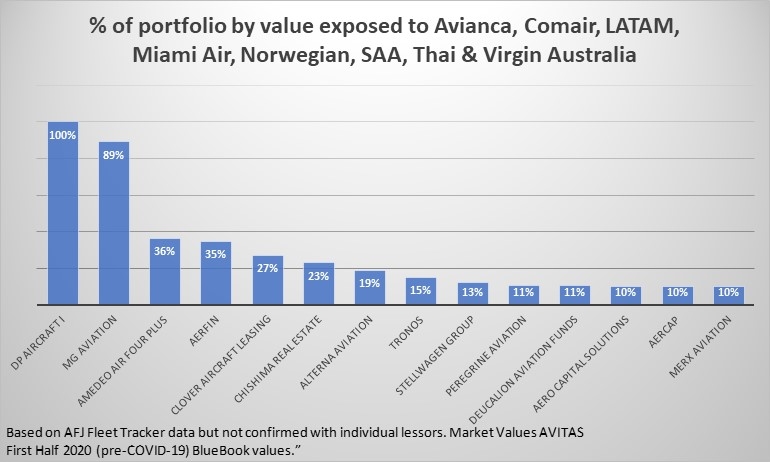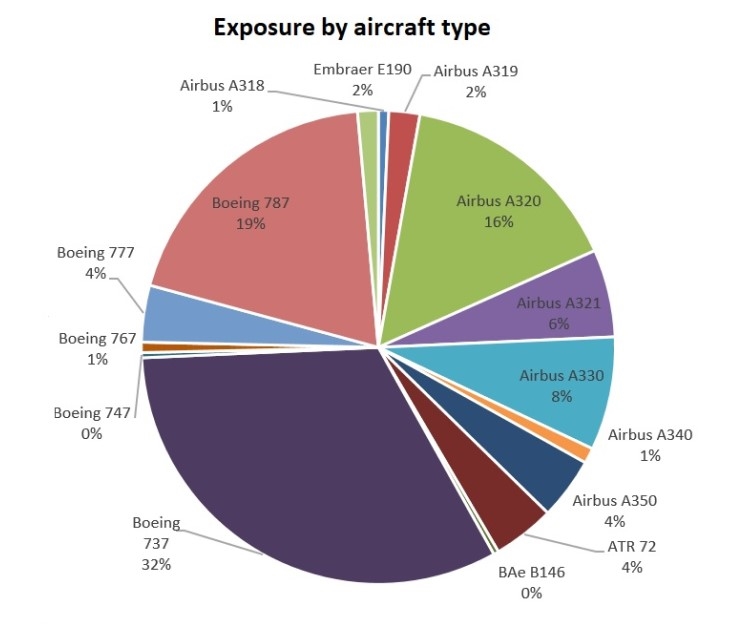Analysis: Lessor exposure to distressed assets
As the Covid-19 crisis pushes more airlines into collapse or administration, lessors big and small are seeing their exposure to distressed assets grow.
Analysis of Airfinance Journal Fleet Tracker data, which is based on market values from Avitas' first-half 2020 (pre-Covid-19) BlueBook but has not been confirmed with lessors, shows that the top end of the scale is DP Aircraft I with distressed assets comprising 100% of its portfolio.
The data covers exposure to Avianca, Comair, LATAM, Miami Air, which has filed for liquidation, Norwegian, South African Airways (SAA), Thai Airways and Virgin Australia.
Total distressed assets stand at $13.2 billion of a total of $276.8 billion among the lessors surveyed, representing 5% of the total by market value.
Of the major lessors, Aercap stands out with 10% exposure to distressed assets, followed by Merx at 10% and SMBC Aviation Capital at 9%.
Aercap has $3.7 billion of distressed asset exposure within a portfolio of $36.6 billion, primarily to LATAM ($1.69 billion) where it has 16 787s and two 767s placed with the Chilean carrier; to Norwegian with $1.21 billion, representing 10 787s; and to Thai Airways, where Aercap has six 787s with a market value of $561 million.
SMBC Aviation Capital has just over $1 billion of assets at airlines in administration. Its greatest exposure is to Avianca, where it has $587 million of assets, comprising a mixture of 10 A320s, A321s, 737s and 787s.
One lessor who spoke to Airfinance Journal on condition of anonymity said that the liquidity available to the larger lessors would help buffer their exposure to distressed assets.
“The upside the larger lessors have is available cash flow to see them through. Also if they own the aircraft they can be more flexible about what to do with them if they do come back after the Chapter 11 process is complete. The ABS
Smaller or more niche players may struggle due to the concentration of assets at airlines in administration.
MG Aviation’s exposure is the second highest, at 89%, as a result of its four 787s placed with Norwegian, with $439 million of $493 million total assets deemed distressed.
Exposure then falls to 36% in the case of Amedeo, which has four Airbus A350s with Thai, representing $516 million of distressed assets from a total portfolio of $1.41 billion.
Aerfin’s exposure to distressed assets stands at 35%, representing $17 million of a total $46 million portfolio.
Clover Aircraft Leasing’s exposure to distressed assets stands at 27%; Chishima Real Estate at 23%; Alterna Aviation at 19%, Tronos at 15%; and Stellwagen Group at 13%.
“There is something more to consider, and that's who actually owns the exposed aircraft,” the source says.
“If you are a servicer, you may not be exposed to the residual risk, but your income is severely impacted as you usually receive a servicing fee based on rent received, or at least a large portion of the fee will depend on the rent being received. If you are a small lessor and you depend on these servicing fees you are going to be hit hard, especially considering any aircraft you do own will most likely be faced with rent deferrals."
However, there is a chance that not all of the leased aircraft with airlines in administration will be rejected.
“I have seen no evidence of preferential treatment, other than the EETC aircraft being rejected over the lessor fleet by LATAM, but you would imagine that the lessors will be seen as strategically important as the airline's credit ratings are impacted by the crisis. Cash for aircraft will become a lot more expensive,” the source says.
None of the lessors surveyed escaped exposure to airlines in administration, although GECAS and Air Lease have exposures very close to 0% of their total portfolios.
In GECAS’s case this represents $109 million of exposure within a $26.2 billion total portfolio, and $12 million of exposure for Air Lease of an almost $17.9 billion portfolio.
Accipiter, Aviation Capital Group, Bocomm Leasing, Carlyle and Standard Chartered are among the lessors to have 1% of their portfolios as distressed assets.
By type, Boeing types are most exposed, with a total of 161 units at carriers in administration, followed by Airbus with 102.
The 737 is the most numerous type in a distressed situation, with 92 units with carriers in administration, followed by 55 787 units. A total of 36 A320s and eight A320neos are classed as distressed assets, as are 22 A330s, 14 A321s and two A321neos, three A340s and 12 A350s.
Eight ATR72-600s are exposed and four ATR 72-400s, of which a total of nine are owned by Avation.
Four Embraer E190s are included in the list, all owned by Falko and placed with Virgin Australia.

